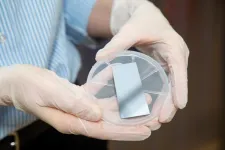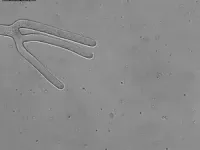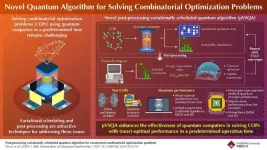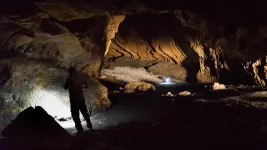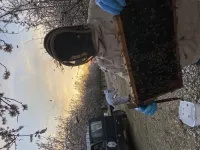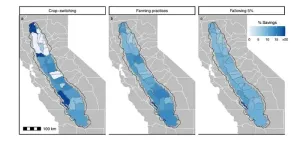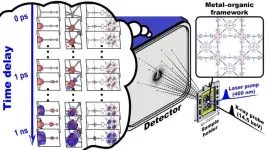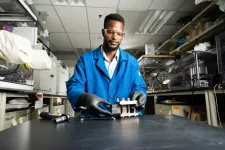(Press-News.org) SAN ANTONIO — March 25, 2024 —Southwest Research Institute is investing internal funding to develop more effective conversion surfaces to allow future spacecraft instruments to collect and analyze low-energy particles. Conversion surfaces are ultra-smooth, ultra-thin surfaces covering a silicon wafer that convert neutral atoms into ions to more effectively detect particles from outer space.
Changing the charge of particles simplifies and enhances detection and analysis capabilities. Dr. Jianliang Lin of the Institute’s Mechanical Engineering Division and Dr. Justyna Sokół of SwRI’s Space Science Division lead the multidisciplinary project. The project builds on the successful creation of conversion surfaces for the IMAP-Lo instrument for the Interstellar Mapping and Acceleration Probe (IMAP) spacecraft. IMAP, which is set to launch in 2025, will help researchers better understand the boundary of our heliosphere, the region of space encompassing the solar system, where the solar wind has a significant influence.
“When low-energy atoms enter the instrument from outer space, they bounce off the conversion surface and either gain or lose an electron, making their electrical charge unbalanced. This makes it easier to increase their speed and analyze their mass and other properties,” Sokół said.
It is vital that these surfaces must maintain their conversion efficiency over the course of sometimes decades-long missions.
“The thickness of the conversion surface is typically less than 50 nanometers, more than 1,000 times thinner than a human hair,” Lin said. “The surface also must be as smooth as possible — close to perfect. If the surface is not smooth enough, particles will be slowed by energy scattering, which makes it much more difficult to detect and analyze their properties.”
Building on research conducted at The University of Bern, Lin and Sokół are now working to create even more effective conversion surfaces made of cadmium telluride (CdTe) and zinc selenide (ZnSe).
“Cadmium telluride and zinc selenide thin films are novel materials for conversion surfaces that could potentially reduce angular scattering on the surface to ultimately improve the conversion effectiveness,” Lin said.
SwRI has succeeded in creating a thin ZnSe film that meets standards for smoothness. The next phase will test the material’s effectiveness as a conversion surface.
“SwRI is uniquely capable of tackling this kind of challenge, with considerable expertise in spacecraft instrumentation and in developing thin films,” Lin said. “That interdisciplinary collaboration made this happen, and that is why we feel confident we can make better, more effective conversion surfaces.”
For more information visit https://www.swri.org/industry/surface-engineering/thin-film-deposition-services or https://www.swri.org/technical-divisions/space-science.
END
SwRI develops more effective particle conversion surfaces for space instruments
Interdisciplinary project creating smoother surfaces to improve low-energy particle detection
2024-03-25
ELSE PRESS RELEASES FROM THIS DATE:
Novel quantum algorithm for high-quality solutions to combinatorial optimization problems
2024-03-25
Combinatorial optimization problems (COPs) have applications in many different fields such as logistics, supply chain management, machine learning, material design and drug discovery, among others, for finding the optimal solution to complex problems. These problems are usually very computationally intensive using classical computers and thus solving COPs using quantum computers has attracted significant attention from both academia and industry.
Quantum computers take advantage of the quantum property of superposition, using specialized qubits, that can exist in an infinite yet contained number of states of 0 or 1 or any combination of the two, to quickly ...
Persian plateau unveiled as crucial hub for early human migration out of Africa
2024-03-25
A new study combining genetic, palaeoecological, and archaeological evidence has unveiled the Persian Plateau as a pivotal geographic location serving as a hub for Homo sapiens during the early stages of their migration out of Africa.
This revelation sheds new light on the complex journey of human populations, challenging previous understandings of our species' expansion into Eurasia.
The study, published in Nature Communications, highlights a crucial period between approximately 70,000 to 45,000 years ago when human populations did not uniformly spread across Eurasia, ...
Honey bees at risk for colony collapse from longer, warmer fall seasons
2024-03-25
PULLMAN, Wash. – The famous work ethic of honey bees might spell disaster for these busy crop pollinators as the climate warms, new research indicates.
Flying shortens the lives of bees, and worker honey bees will fly to find flowers whenever the weather is right, regardless of how much honey is already in the hive. Using climate and bee population models, researchers found that increasingly long autumns with good flying weather for bees raises the likelihood of colony collapse in the spring.
The study, published in Scientific Reports, focused on the Pacific Northwest but holds implications for hives across the U.S. The researchers ...
20,000 years of shared history on the Persian plateau
2024-03-25
All present day non African human populations are the result of subdivisions that took place after their ancestors left Africa at least 60.000 years ago. How long did it take for these separations to take place? Almost 20.000 years, during which they were all part of a single population. Where did they live for all this time? We don’t know, yet.
This is a conversation that could have taken place one year ago, now it is possible to give clearer answers to these questions thanks to the study recently published in Nature Communications (1) led by the researchers from the University ...
New UM study reveals unintended consequences of fire suppression
2024-03-25
MISSOULA – The escalation of extreme wildfires globally has prompted a critical examination of wildfire management strategies. A new study from the University of Montana reveals how fire suppression ensures that wildfires will burn under extreme conditions at high severity, exacerbating the impacts of climate change and fuel accumulation.
The study used computer simulations to show that attempting to suppress all wildfires results in fires burning with more severe ecological impacts, with accelerated increases in burned area beyond those expected from fuel accumulation or climate change.
“Fire suppression has unintended consequences,” said lead author Mark Kreider, a Ph.D. ...
Small changes can yield big savings in agricultural water use
2024-03-25
(Santa Barbara, Calif.) — While Hollywood and Silicon Valley love the limelight, California is an agricultural powerhouse, too. Agricultural products sold in the Golden State totaled $59 billion in 2022. But rising temperatures, declining precipitation and decades of over pumping may require drastic changes to farming. Legislation to address the problem could even see fields taken out of cultivation.
Fortunately, a study out of UC Santa Barbara suggests less extreme measures could help address California’s water issues. Researchers combined remote sensing, big data and machine ...
Humans pass more viruses to other animals than we catch from them
2024-03-25
Humans pass on more viruses to domestic and wild animals than we catch from them, according to a major new analysis of viral genomes by UCL researchers.
For the new paper published in Nature Ecology & Evolution, the team analysed all publicly available viral genome sequences, to reconstruct where viruses have jumped from one host to infect another vertebrate species.
Most emerging and re-emerging infectious diseases are caused by viruses circulating in animals. When these viruses cross over from animals into humans, a process known as zoonosis, they can cause disease outbreaks, epidemics and pandemics such as Ebola, flu or Covid-19. Given the enormous impact ...
Filming ultrafast molecular motions in single crystal
2024-03-25
Understanding the behavior of matter is crucial for advancing scientific fields like biology, chemistry, and materials science. X-ray crystallography has been instrumental in this pursuit, allowing scientists to determine molecular structures with precision. In traditional X-ray crystallography experiments, a single crystal is exposed to X-rays multiple times to obtain diffraction signals. This poses a problem, where the sample has its structure altered or damaged by X-ray exposure.
In recent years, advances in technology have allowed for the development of “time-resolved serial femtosecond crystallography” (TR-SFX). In serial ...
Better phosphorus use can ensure its stocks last more than 500 years and boost global food production - new evidence shows
2024-03-25
More efficient use of phosphorus could see limited stocks of the important fertiliser last more than 500 years and boost global food production to feed growing populations.
But these benefits will only happen if countries are less wasteful with how they use phosphorus, a study published today in Nature Food shows.
Around 30-40 per cent of farm soils have over-applications of phosphorus, with European and North American countries over-applying the most.
The global population is due to hit nearly 10 billion by 2050 and it is estimated that to feed ...
New all-liquid iron flow battery for grid energy storage
2024-03-25
RICHLAND, Wash.— A commonplace chemical used in water treatment facilities has been repurposed for large-scale energy storage in a new battery design by researchers at the Department of Energy’s Pacific Northwest National Laboratory. The design provides a pathway to a safe, economical, water-based, flow battery made with Earth-abundant materials. It provides another pathway in the quest to incorporate intermittent energy sources such as wind and solar energy into the nation’s electric grid.
The researchers report ...
LAST 30 PRESS RELEASES:
Making lighter work of calculating fluid and heat flow
Normalizing blood sugar can halve heart attack risk
Lowering blood sugar cuts heart attack risk in people with prediabetes
Study links genetic variants to risk of blinding eye disease in premature infants
Non-opioid ‘pain sponge’ therapy halts cartilage degeneration and relieves chronic pain
AI can pick up cultural values by mimicking how kids learn
China’s ecological redlines offer fast track to 30 x 30 global conservation goal
Invisible indoor threats: emerging household contaminants and their growing risks to human health
Adding antibody treatment to chemo boosts outcomes for children with rare cancer
Germline pathogenic variants among women without a history of breast cancer
Tanning beds triple melanoma risk, potentially causing broad DNA damage
Unique bond identified as key to viral infection speed
Indoor tanning makes youthful skin much older on a genetic level
Mouse model sheds new light on the causes and potential solutions to human GI problems linked to muscular dystrophy
The Journal of Nuclear Medicine ahead-of-print tip sheet: December 12, 2025
Smarter tools for peering into the microscopic world
Applications open for funding to conduct research in the Kinsey Institute archives
Global measure underestimates the severity of food insecurity
Child survivors of critical illness are missing out on timely follow up care
Risk-based vs annual breast cancer screening / the WISDOM randomized clinical trial
University of Toronto launches Electric Vehicle Innovation Ontario to accelerate advanced EV technologies and build Canada’s innovation advantage
Early relapse predicts poor outcomes in aggressive blood cancer
American College of Lifestyle Medicine applauds two CMS models aligned with lifestyle medicine practice and reimbursement
Clinical trial finds cannabis use not a barrier to quitting nicotine vaping
Supplemental nutrition assistance program policies and food insecurity
Switching immune cells to “night mode” could limit damage after a heart attack, study suggests
URI-based Global RIghts Project report spotlights continued troubling trends in worldwide inhumane treatment
Neutrophils are less aggressive at night, explaining why nighttime heart attacks cause less damage than daytime events
Menopausal hormone therapy may not pose breast cancer risk for women with BRCA mutations
Mobile health tool may improve quality of life for adolescent and young adult breast cancer survivors
[Press-News.org] SwRI develops more effective particle conversion surfaces for space instrumentsInterdisciplinary project creating smoother surfaces to improve low-energy particle detection
